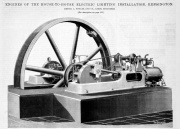Difference between revisions of "Kensington Electric Lighting Station"
| Line 1: | Line 1: | ||
[[Image:Im1889EnV67-p118.jpg|thumb| 1889. [[Kensington Electric Lighting Station]].]] | [[Image:Im1889EnV67-p118.jpg|thumb| 1889. [[Kensington Electric Lighting Station]].]] | ||
[[Image:Im1889EnV67-p435.jpg|thumb| 1889. Kensington | [[Image:Im1889EnV67-p435.jpg|thumb| 1889. [[J. Fowler and Co]] engine installed at Kensington for the [[House To House Electric Light Supply Co]].]] | ||
1889 The [[House To House Electric Light Supply Co]] was one of the early companies supplying electricity in London. It used the a.c. method of generation and distribution<ref>The Times, Aug 19, 1891</ref>. It opened its central generating station in Kensington, adjacent to West Brompton station. The system was designed by the company's engineer, Mr William Lowrie, on the lines of his design for [[Eastbourne Electric Lighting Co|Eastbourne]], with Mr Hall. The high voltage electricity was converted to low tension at each house by [[Lowrie-Hall]] converters. 3 sets of generating equipment, each capable of lighting 4000 lamps were installed initially<ref>The Pall Mall Gazette, January 25, 1889</ref>. Two (sic) [[Elwell-Parker|Lowrie-Parker]]<ref>[[The Engineer]] of 24th May 1889 p434</ref> dynamos were specially made for the plant; the maximum load that could be handled was 100kW; the '''Lowrie-Hall''' regulator was used for controlling and metering the system and '''Lowrie-Hall''' converters for reducing the voltage at each customer's premises<ref>[[The Engineer 1889/02/08]]</ref>. | 1889 The [[House To House Electric Light Supply Co]] was one of the early companies supplying electricity in London. It used the a.c. method of generation and distribution<ref>The Times, Aug 19, 1891</ref>. It opened its central generating station in Kensington, adjacent to West Brompton station. The system was designed by the company's engineer, Mr William Lowrie, on the lines of his design for [[Eastbourne Electric Lighting Co|Eastbourne]], with Mr Hall. The high voltage electricity was converted to low tension at each house by [[Lowrie-Hall]] converters. 3 sets of generating equipment, each capable of lighting 4000 lamps were installed initially<ref>The Pall Mall Gazette, January 25, 1889</ref>. Two (sic) [[Elwell-Parker|Lowrie-Parker]]<ref>[[The Engineer]] of 24th May 1889 p434</ref> dynamos were specially made for the plant; the maximum load that could be handled was 100kW; the '''Lowrie-Hall''' regulator was used for controlling and metering the system and '''Lowrie-Hall''' converters for reducing the voltage at each customer's premises<ref>[[The Engineer 1889/02/08]]</ref>. | ||
Latest revision as of 11:42, 15 November 2021

1889 The House To House Electric Light Supply Co was one of the early companies supplying electricity in London. It used the a.c. method of generation and distribution[1]. It opened its central generating station in Kensington, adjacent to West Brompton station. The system was designed by the company's engineer, Mr William Lowrie, on the lines of his design for Eastbourne, with Mr Hall. The high voltage electricity was converted to low tension at each house by Lowrie-Hall converters. 3 sets of generating equipment, each capable of lighting 4000 lamps were installed initially[2]. Two (sic) Lowrie-Parker[3] dynamos were specially made for the plant; the maximum load that could be handled was 100kW; the Lowrie-Hall regulator was used for controlling and metering the system and Lowrie-Hall converters for reducing the voltage at each customer's premises[4].
See Also
Sources of Information
- ↑ The Times, Aug 19, 1891
- ↑ The Pall Mall Gazette, January 25, 1889
- ↑ The Engineer of 24th May 1889 p434
- ↑ The Engineer 1889/02/08


